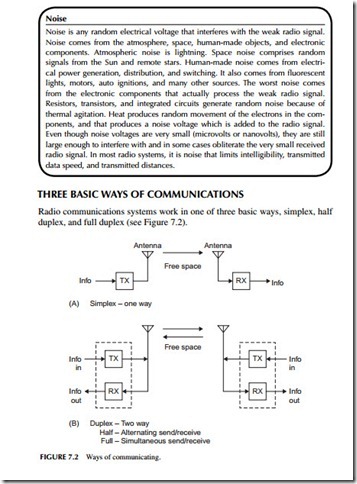THREE BASIC WAYS OF COMMUNICATIONS
Radio communications systems work in one of three basic ways, simplex, half duplex, and full duplex (see Figure 7.2).
Simplex
Simplex is one-way communications. Examples are radio broadcasting, paging, and remote control. A radio telescope is also one-way: there is a transmit- ter at one end and a receiver at the other.
Half Duplex
Duplex means two-way, and most radio communications are really two-way affairs. There is a transmitter and a receiver at both ends of the communications system. Both parties can send and receive. And there are two types of duplex systems, half duplex and full duplex.
In half-duplex systems, only one party can transmit at a time. Those communicating with one another take turns talking. This is the kind of radio where you have to say “over” or “come back” after you finish speaking to let the other party know that it is time for her or him to talk. CB radio is like this. Most two-way communications services (police, fire, taxi, aircraft, marine, etc.) use this method because it is cheap and simple. Fax machines are half duplex. Most computer modems are half duplex.
Full Duplex
Full duplex is more complex and expensive. This is two-way radio where both parties can both send and receive simultaneously. Probably the best example of this is a cordless or cellular telephone. It is great to be able to talk and listen at the same time.
